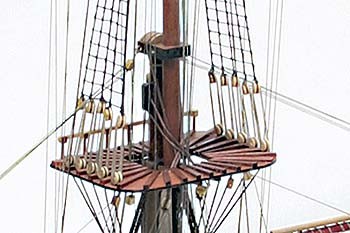Santisima Trinidad Cross Section – OcCre
$224.99
Historic Scale Wooden Model Ship Kit by OcCre Models OC16800
Width 16-1/3″ Height 33-3/4″ Scale 1:90
Entry Level
Plank-On-Frame Construction
INCLUDES PRE-SEWN SAILS
You may also like…
Information
Santisima Trinidad Cross-Section (OC16800)
Historic Scale Wooden Model Ship Kit by OcCre Models
Width 16-1/3″ Height 33-3/4″ Scale 1:90
Entry Level
Plank-On-Frame Construction
INCLUDES PRE-SEWN SAILS
Now, you can get a close-up view of the interior workings of the Santisima Trinidad, Spain’s largest battleship at the time of the Battle of Trafalgar. In many ways more interesting than the full hulled model, the cross section takes less time to build and less space to display.
OcCre’s Santisima Trinidad kit is packed with high quality materials and authentic detail. Wooden parts are laser cut. Hull planking is done in light beechwood and rich African walnut. Decks are also covered with individual planking strips. A rich array of fittings includes wooden grating, blocks and deadeyes, carved wooden barrels, brass eyebolts, belaying pins, nails and chain, metal hoops, cleats and gun-ports. No detail has been overlooked – you’ll even get scale ballast! Fourteen brass cannon on burnished metal carriages replicate original armament. Four diameters of rigging line, pre-sewn and ready-to-mount sails, silk-screened pennants, wooden display base and pedestals complete the kit. Full sized plans feature 2-color rig plan. A booklet of over 100 color photos accompanies clearly written assembly instructions.
Built in Havana in 1769, Santisima Trinidad carried 120 guns on three decks. Badly damaged in the battle of Cape St. Vincent in 1799, she was rebuilt with the addition of a fourth deck and the number of cannon increased to 136, making her the largest ship of her time. In 1805, she sailed into the Battle of Trafalgar with a crew of 1,048 men and her immense 4-decked sides showing the barrels of her formidable guns. The British disabled and captured her during the battle. She sank in a storm the following day, ending her 35-year service to the Spanish Navy.
MORE INFO ON SANTISIMA TRINIDAD
The Spanish ship Santasima Trinidad (officially named Santisima Trinidad y Nuestra Senora del Buen Fin) was a first-rate ship of the line of 120 guns (when first built). Her armament was later increased to as many as 144 guns on four decks. For many years she was the biggest warship in the world.
She was built at Havana, Cuba, to a design by Irish naval architect Matthew Mullan and launched in 1769 as an 120-gun three-decker (some sources say 116 or 112 guns). For many years she was the biggest warship in the world, being considerably larger than her British contemporary Victory and somewhat bigger than the French Bretagne.
There is no complete plan of the ship in existence, but there are of the 112-gun ship from 1765, which might be found the original dimensions of the ship : (the next dimension are in feet of the burgos (278,6 mm), and metres.) length = 213 2/3 (59,53), keel= 182 5/12 (50,82), beam= 57 3/4 (16,09), depth= 28 11/12 (8,06). For exact figures, and those in the General Characteristics frame, see: Jos̩ Cayuela Fernandez РTrafalgar, hombres y naves entre dos ̩pocas РAriel 2004.
In 1795, her forecastle was joined to her quarterdeck to create a fourth deck containing a battery of eight pounder guns, giving her a total of 144 guns. Her armament seems to have been quickly reduced to 130 to 136 guns. Even so, she now carried the largest number of guns of any single ship of her time. As the only ship with four gun decks, she was reputed to be the largest warship in the world, although she had actually been surpassed in sheer size by the new French 120-gun ships such as the Océan and Orient.
The additional weight of guns so high above her waterline made her sail poorly, leading to her nickname, El Poderoso. SantÃsima Trinidad remains famous as the only four-decker ship of the line ever built; although the British designed one, Duke of Kent, they never built her.
In July 1779, Spain declared war on Great Britain, joining France in support of the American colonists in the American War of Independence. SantÃsima Trinidad became the flagship of the Spanish fleet, taking part in the Franco-Spanish operations in the English Channel in the late summer of that year.
In 1780 she took part in the capture of an English convoy of 51 ships.
In 1782 she was incorporated into the Mediterranean Squadron, participating in the second siege of Gibraltar and she fought in the brief and indecisive Battle of Cape Spartel.
n 1795, she was modified by the addition of extra 8-pounder guns on a new deck between her forecastle and quarterdeck.
In 1797, she was the flagship of Teniente General José de Córdoba, the Spanish commander, at Battle of Cape St Vincent on 14 February 1797, where she was badly damaged and nearly captured by the British fleet. She was first in action with the British ship Captain, 74, commanded by Commodore Nelson, and Culloden, 74. She was then attacked by the Blenheim, 90, Orion, 74, Irresistible, 74 and Excellent, 74. By now she was severely damaged, having lost all her masts and with half of her crew killed or wounded. She struck her colors (surrendered), but the British failed to take possession and she was saved by the Pelayo, 74 and Principe de Asturias, 112. Several days later, SantÃsima Trinidad was spotted, still damaged, making her way back to Spain, and engaged by the frigate Terpsichore, 32, but she escaped. She eventually returned to Cadiz for repairs.
Eight years later, commanded by Francisco Javier Uriarte and Rear Admiral Baltasar Hidalgo de Cisneros, she took part in the Battle of Trafalgar on October 21, 1805, as part of the combined Franco-Spanish fleet. Her great size and position immediately ahead of the fleet flagship Bucentaure made her a target for the British fleet, and she came under concentrated attack by several ships. She lost her mast and eventually surrendered to the Neptune, commanded by Captain Thomas Fremantle. She was taken in tow by the Prince, but sank in a storm that blew up the day after the battle.
For a good reference on building model ships, please click here.
Have questions about any of our products? Please don’t hesitate to contact us!
You may also like…
any/all videos that may be on this site were found on youtube and are not produced by historicships.com. If your video is here and you do not wish it to be here please let us know and we will remove it.







